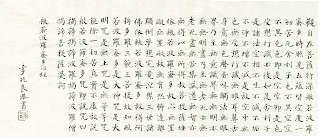1-12-05
"THE BODHISATTVA RELIES ON PRAJNA PARAMITA WITH NO HINDERANCE IN THE MIND. NO HINDERANCE, THEREFORE NO FEAR."
All kinds of people seem to be talking about slacklining and meditation these days - and no doubt they're onto something. But what do Buddhism and slackline practice really have in common? Rather than try to encapsulate the many ways people find Dharma in their slackline practice, it seems better to simply offer a translation of a teaching that I think points in the general direction.
Find below a wonderful translation of the Heart Sutra, the scriptural pinnicle of Mahayana Buddhism . It comes from the Perfection of Wisdom cycle of teachings and was fittingly delivered on Vulture's Peak, a rocky hill in India where many timeless teachings were laid down - as many as grains of sand in the Ganges river.
MAHA PRAJNA PARAMITA HRIDAYA SUTRA
AVALOKITESTVARA, THE BODHISATTVA OF COMPASSION, DOING DEEP PRAJNA PARAMITA, CLEARLY SAW THAT THE FIVE SKANDHAS ARE SUNYATA, THUS TRANSCENDING MISFORTUNE AND SUFFERING. O SARIPUTRA, FORM IS NO OTHER THAN SUNYATA, SUNYATA IS NO OTHER THAN FORM. FORM IS EXACTLY SUNYATA, SUNYATA EXACTLY FORM. FEELING, THOUGHT, VOLITION, AND CONSCIOUSNESS ARE LIKEWISE LIKE THIS. O SARIPUTRA, REMEMBER, DHARMA IS FUNDAMENTALLY SUNYATA. NO BIRTH, NO DEATH. NOTHING CAN INCREASE, NOTHING CAN DECREASE. HENCE: IN SUNYATA, NO FORM, NO FEELING, NO THOUGHT, NO VOLITION, NO CONSCIOUSNESS; NO EYES, NO EARS, NO NOSE, NO TONGUE, NO BODY, NO MIND; NO SEEING, NO HEARING, NO SMELLING, NO TASTING, NO TOUCHING, NO THINKING; NO WORLD OF SIGHT, NO WORLD OF CONSCIOUSNESS; NO IGNORANCE AND NO END TO IGNORANCE; NO OLD AGE AND DEATH AND NO END TO OLD AGE AND DEATH. NO SUFFERING, NO CRAVING, NO EXTINCTION, NO PATH; NO WISDOM, NO ATTAINMENT. INDEED THERE IS NOTHING TO BE ATTAINED; THE BODHISATTVA RELIES ON PRAJNA PARAMITA WITH NO HINDERANCE IN THE MIND. NO HINDERANCE, THEREFORE NO FEAR. FAR BEYOND UPSIDE-DOWN VIEWS, AT LAST NIRVANA. PAST, PRESENT, FUTURE, ALL BUDDHAS, BODHISATTVAS, RELY ON PRAJNA PARAMITA AND THEREFORE REACH THE MOST SUPREME ENLIGHTENMENT. THEREFORE KNOW: PRAJNA PARAMITA IS THE GREATEST DHARANI, THE BRIGHTEST DHARANI, THE HIGHEST DHARANI, THE INCOMPARABLE DHARANI. IT COMPLETELY CLEARS ALL SUFFERING. THIS IS THE TRUTH, NOT A LIE. SO SET FORTH THE PRAJANA PARAMITA DHARANI. SET FORTH THIS DHARANI AND SAY: GATE' GATE' PARGATE' PARASAMGATE', BODHISVAHA HEART SUTRA.
-TRANSLATED BY EIDO T. SHIMANO ROSHI, ABBOTT DAI BOSATSU ZENDO KONGO JI
















